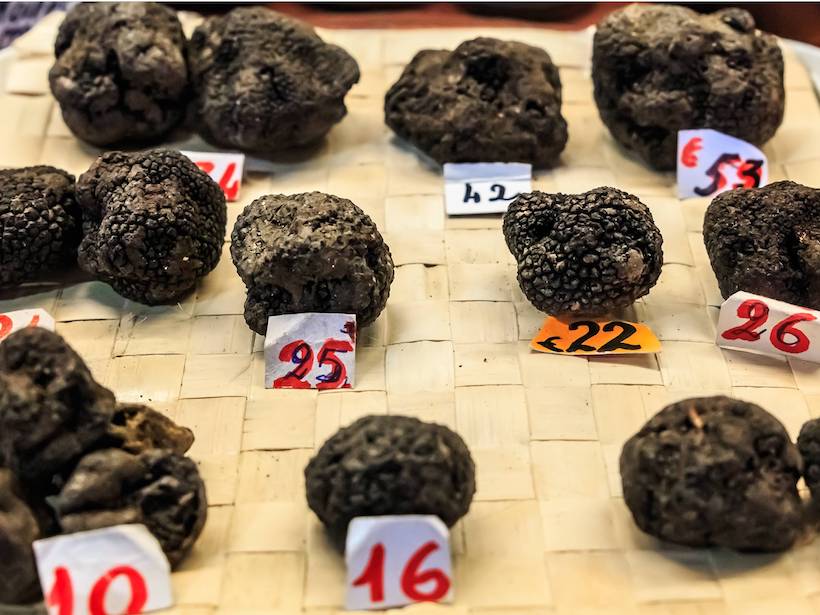A truffle might not be much to look at, but chefs worldwide revere these subterranean-dwelling fungi for their intense, earthy flavors. Now, scientists have looked to the future of truffle cultivation in Europe by modeling three different climate-warming scenarios. They found that climate change will substantially increase the cultivation potential of one species of truffle commonly used in cooking. Given that truffle farming can be lucrative, it appears that climate change has a culinary silver lining, at least for the niche world of truffles, the researchers concluded.
An Expensive Fungus
Tomáš Čejka, a climate change scientist at the Global Change Research Institute of the Czech Academy of Sciences in Brno, and his colleagues focused on two species of truffles: Tuber aestivum (Burgundy truffle) and Tuber melanosporum (Périgord truffle). These truffles are among the most commonly used in kitchens and cost hundreds of dollars per kilogram. (They’re not quite as renowned as Tuber magnatum, however, a species of white truffle that commands ever higher prices.)
Truffles grow naturally near the roots of such trees as oaks, hazels, spruces, and pines. They prefer alkaline soils, and unlike most agricultural crops, they cannot be coaxed into production. (“A truffle farmer does not plant truffles, he plants oak trees,” a journalist wrote.) When a truffle is ripe, it exudes an aroma perceptible to sensitive noses—for centuries, people have relied on pigs and dogs to sniff out buried truffles.

A Look into the Future
Čejka and his colleagues began by mining 57 previously published research studies to determine the ecological conditions most conducive to truffle growth. They focused on four primary parameters: temperature, precipitation, elevation, and soil pH. The researchers then used this information to estimate the cultivation potential of Burgundy and Périgord truffles on agricultural land in the Czech Republic given both current and future climate conditions.
“You may be looking at 5, 10, 15 years before you get your first truffles.”
The team analyzed the average output of five global climate models assuming low-, medium-, and high-emission Representative Concentration Pathways (RCP 2.6, RCP 4.5, and RCP 8.5). They focused on the time interval 2041–2060 and averaged the outputs they obtained to estimate values representative of the year 2050.
It’s important to look to the future when it comes to growing truffles, said Shannon Berch, a mycologist at the University of British Columbia in Vancouver, Canada, not involved in the research. That’s because it takes a while to establish an orchard, she said. “You may be looking at 5, 10, 15 years before you get your first truffles.”
Make Way for More Périgords
Čejka and his collaborators found that Périgord truffles benefited from all three warming scenarios: There were consistent gains in the sizes of moderate- and high-suitability areas for growing this species and consistent losses in the sizes of very low and low-suitability areas. The future of Burgundy truffles, on the other hand, was less clear-cut: The cultivation potential of the species increased for RCP 2.6, but there were no clear trends for RCP 4.5 and RCP 8.5.
Climate change will therefore likely be a boon for Périgord truffle cultivation in the Czech Republic, the researchers concluded. Given the high retail prices of truffles, that’s potentially good news for farmers’ pockets, Čejka and his colleagues suggested. There are ecological benefits to truffle cultivation as well, such as habitat conservation of large trees and land use diversification, the researchers proposed.
“It was unique and unlike anything else.”
These results were published in December in Scientific Reports.
It would make sense to redo this analysis in other areas of the world in which truffles are grown, said Charles Lefevre, the founder of New World Truffieres Inc., a company specializing in truffle cultivation, and a past president of the North American Truffling Society. Good places to focus on include the United States and Australia, Lefevre said. “Australia is already the fourth-largest producer of Périgord truffles and could potentially overtake Italy in the next few years.”
Čejka recently had the opportunity to taste the subject of his research—he dined on Périgord truffles at a scientific conference. They had a strong aroma and an earthy flavor, he said. It was “unique and unlike anything else.”
—Katherine Kornei (@KatherineKornei), Science Writer
Citation:
Kornei, K. (2021), A culinary silver lining of climate change: More truffles, Eos, 102, https://doi.org/10.1029/2021EO153331. Published on 13 January 2021.
Text © 2021. The authors. CC BY-NC-ND 3.0
Except where otherwise noted, images are subject to copyright. Any reuse without express permission from the copyright owner is prohibited.

